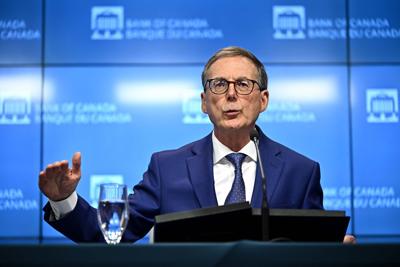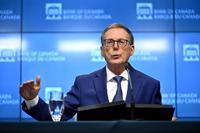OTTAWA - Financial markets and forecasters are betting on another jumbo interest rate cut from the Bank of Canada on Wednesday, which would bring its key rate down to 3.25 per cent.Â
Statistics Canada's latest jobs report tilted expectations in favour of a half-percentage point cut.Â
The Friday report revealed the unemployment rate jumped to 6.8 per cent in November — up from 6.5 per cent a month earlier — as more people looked for work.
November marked Canada's highest jobless rate since January 2017, outside of the COVID-19 pandemic.Â
CIBC Capital Markets chief economist Avery Shenfeld justified a larger cut by pointing to the fact that forecasters expect the central bank to bring its key interest rate down to three per cent or less in the coming months anyway.
"If so, there’s no reason to think that cutting 50 basis points, to 3.25 per cent, could be overdoing it," wrote Shenfeld on Friday.Â
"So 'why not' get there next week, rather than early next year, if we’re going to end up needing even more interest rate relief in 2025? Why not give the economy more of what it needs a bit earlier?"Â
The Bank of Canada has lowered its key interest rate four consecutive times since June, cutting rates faster than previously expected. In October, it cut its policy rate by half a percentage point in response to inflation returning to its two per cent target.Â
Governor Tiff Macklem wouldn't say at the time whether the central bank expects to deliver another large rate cut, and instead signalled the size of the next rate decision would be data-dependent.
Canada's inflation rate was two per cent in October and is expected to remain around the target moving forward.Â
The central bank's back-to-back rate cuts are also in response to lacklustre economic growth. Macklem has said the Bank of Canada now wants to see the economy regain momentum.
The ºÚÁϳԹÏÍø economy in the third quarter shrank on a per-person basis for a sixth consecutive quarter, extending an all-too-familiar trend of high rates stifling business investment and constraining growth.
Real gross domestic product grew at an annualized rate of one per cent in the third quarter, down from 2.2 per cent in the second quarter.
The figure was in line with economists’ expectations, but lower than the Bank of Canada’s October forecast of 1.5 per cent.
"Canada’s economic backdrop has yet to crumble in a way that would cause the (Bank of Canada) to panic, but it is also clear that interest rates are higher than they need to be for inflation to hold at the central bank’s two per cent target," RBC said in a report on Friday.
This report by ºÚÁϳԹÏÍø was first published Dec. 9, 2024.Â








































